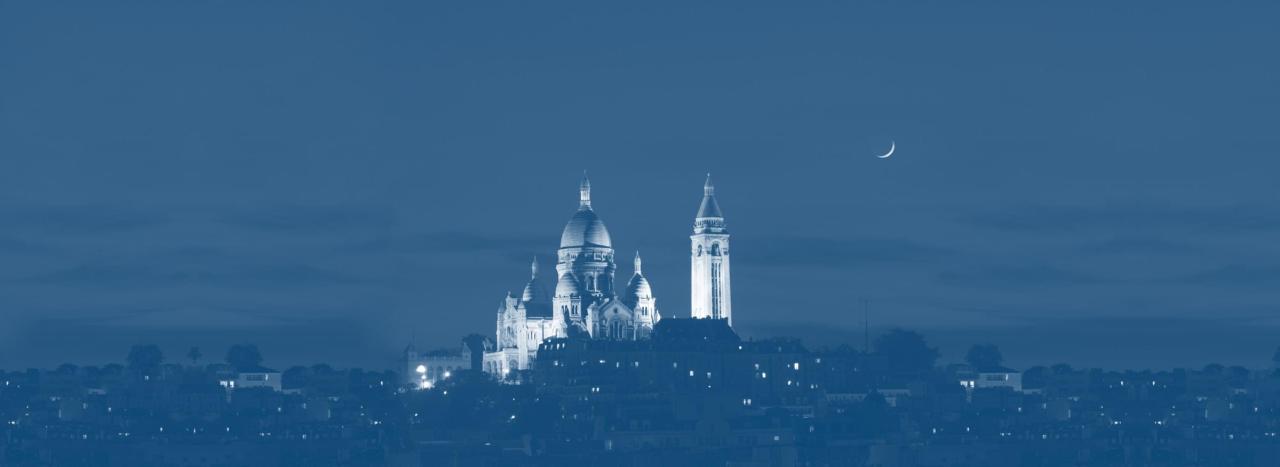Perched atop the highest point in Paris, the butte of Montmartre, the Basilica of the Sacré-Cœur (Sacred Heart) stands as an iconic landmark, its brilliant white dome dominating the city’s skyline. More than just a stunning architectural marvel, the Sacré-Cœur is a testament to faith, repentance, and enduring hope, attracting millions of pilgrims and tourists alike each year. Its story is intertwined with historical turmoil, artistic expression, and the profound practice of perpetual adoration.
Historical Context: A Vow and its Fulfillment
The construction of the Sacré-Cœur was conceived in the aftermath of the Franco-Prussian War (1870-1871) and the tumultuous Paris Commune. France suffered a devastating defeat, and the nation was deeply divided. Alexandre Legentil and Hubert Rohault de Fleury, two prominent figures, proposed the construction of a basilica dedicated to the Sacred Heart of Jesus as a national vow of repentance and atonement for the perceived moral failings of the French people, which they believed had led to the nation’s misfortunes. They saw it as an act of national contrition and a plea for divine mercy and restoration.
This proposal resonated with many, particularly those who held conservative and Catholic views. The National Assembly officially sanctioned the project in 1873, declaring it a matter of national significance. The chosen site, the butte of Montmartre, held historical and symbolic weight. It was believed to be the site of the martyrdom of Saint Denis, the patron saint of Paris, and had also been a center of revolutionary activity during the Commune. By building the basilica on this site, proponents aimed to reclaim it for faith and order.
Architectural Grandeur: A Romanesque-Byzantine Fusion
A national competition was held to select the architect, and Paul Abadie emerged as the winner. Abadie’s design drew inspiration from Romanesque and Byzantine architectural styles, a departure from the Gothic style prevalent in many French cathedrals. Construction began in 1875 and continued for nearly four decades, facing numerous challenges, including financial constraints and Abadie’s own death in 1884.
The basilica is constructed of Château-Landon stone, a type of travertine that hardens and bleaches white over time, contributing to its distinctive luminosity. The prominent central dome, reaching a height of 83 meters, is flanked by four smaller domes, creating a visually striking silhouette. The facade features three arches adorned with sculptures depicting Christ with the Sacred Heart, flanked by figures of Joan of Arc and Saint Louis IX, representing French patriotism and piety.
The interior of the Sacré-Cœur is equally impressive. The vast nave is bathed in soft light filtering through stained glass windows, creating a serene and contemplative atmosphere. The apse is dominated by a magnificent mosaic, one of the largest in the world, depicting Christ with outstretched arms, welcoming all to his Sacred Heart. The mosaic, designed by Luc-Olivier Merson, is a masterpiece of artistry and religious symbolism.
Perpetual Adoration: A Constant Flame of Prayer
From its inception, the Sacré-Cœur was intended to be a place of prayer and adoration. In 1885, even before the basilica was fully completed, the practice of perpetual adoration of the Blessed Sacrament was established. This means that, day and night, 24 hours a day, 7 days a week, the Eucharist is exposed in the monstrance, and adorers are present to pray in its presence.
This unbroken chain of prayer has continued for over a century, making the Sacré-Cœur a unique and powerful spiritual center. Volunteers from all walks of life commit to spending an hour or more each week in adoration, offering their prayers for the needs of the Church, the world, and their personal intentions.
The practice of perpetual adoration is deeply rooted in Catholic tradition and reflects the belief in the Real Presence of Christ in the Eucharist. Adorers believe that by spending time in prayer before the Blessed Sacrament, they are entering into a direct encounter with Christ, drawing closer to him and receiving his grace.
The atmosphere of silence and reverence in the adoration chapel is palpable. The soft glow of candles, the hushed whispers of prayers, and the sense of profound peace create a space for deep contemplation and spiritual renewal. Many visitors to the Sacré-Cœur, even those who are not Catholic, are drawn to the chapel, sensing the presence of something sacred and transcendent.
The Sacré-Cœur Today: A Symbol of Paris and a Sanctuary of Prayer
Today, the Basilica of the Sacré-Cœur remains one of the most visited monuments in Paris. Tourists flock to admire its architectural beauty, its stunning views of the city, and its rich history. However, the Sacré-Cœur is more than just a tourist attraction. It is a living, breathing place of worship, a sanctuary of prayer, and a symbol of enduring faith.
The practice of perpetual adoration continues to be a central part of the basilica’s mission, attracting a diverse community of adorers from around the world. The Sacré-Cœur serves as a reminder of the power of prayer, the importance of repentance, and the enduring hope that lies in the Sacred Heart of Jesus.
Beyond its religious significance, the Sacré-Cœur has also become an important part of the cultural fabric of Paris. Its image is ubiquitous, appearing on postcards, posters, and countless souvenirs. It is a symbol of the city, instantly recognizable and deeply cherished.
In conclusion, the Basilica of the Sacré-Cœur, Montmartre, is a multifaceted landmark that embodies faith, art, and history. From its origins as a national vow to its enduring practice of perpetual adoration, the Sacré-Cœur stands as a beacon of hope and a testament to the power of prayer. Whether you are a devout pilgrim, a curious tourist, or simply someone seeking a moment of peace, the Sacré-Cœur offers a unique and unforgettable experience. It is a place where the sacred and the secular intertwine, where beauty and faith converge, and where the heart of Paris beats strong.

